Research Methods 2: Smart Contract Performance and Risk Analysis
VerifiedAdded on 2020/05/16
|89
|13154
|51
Report
AI Summary
This research report delves into the realm of smart contracts, exploring their fundamental concepts and the associated risks. The study investigates the impact of human and risk factors on the performance of smart contracts, with a focus on risk management strategies. It examines the benefits and challenges of smart contracts, emphasizing data security concerns within blockchain technology. The research employs a positivism philosophy with a deductive approach, utilizing a quantitative analysis of primary data collected through an online survey. The report covers the background of smart contracts, literature review on blockchain technology, methodology, data findings, discussion, and conclusion with recommendations. The aim is to understand smart contract concepts and its risk management processes and identify the risks involved in the implementation of the smart contract. The research aims to answer the questions related to smart contract and blockchain technology, the risks involved in the implementation of smart contract, and the implementation of risk management process to mitigate risks in smart contracts. The study also discusses the application of the blockchain technology by organizations in the market and identifies various risks involved in this technology.
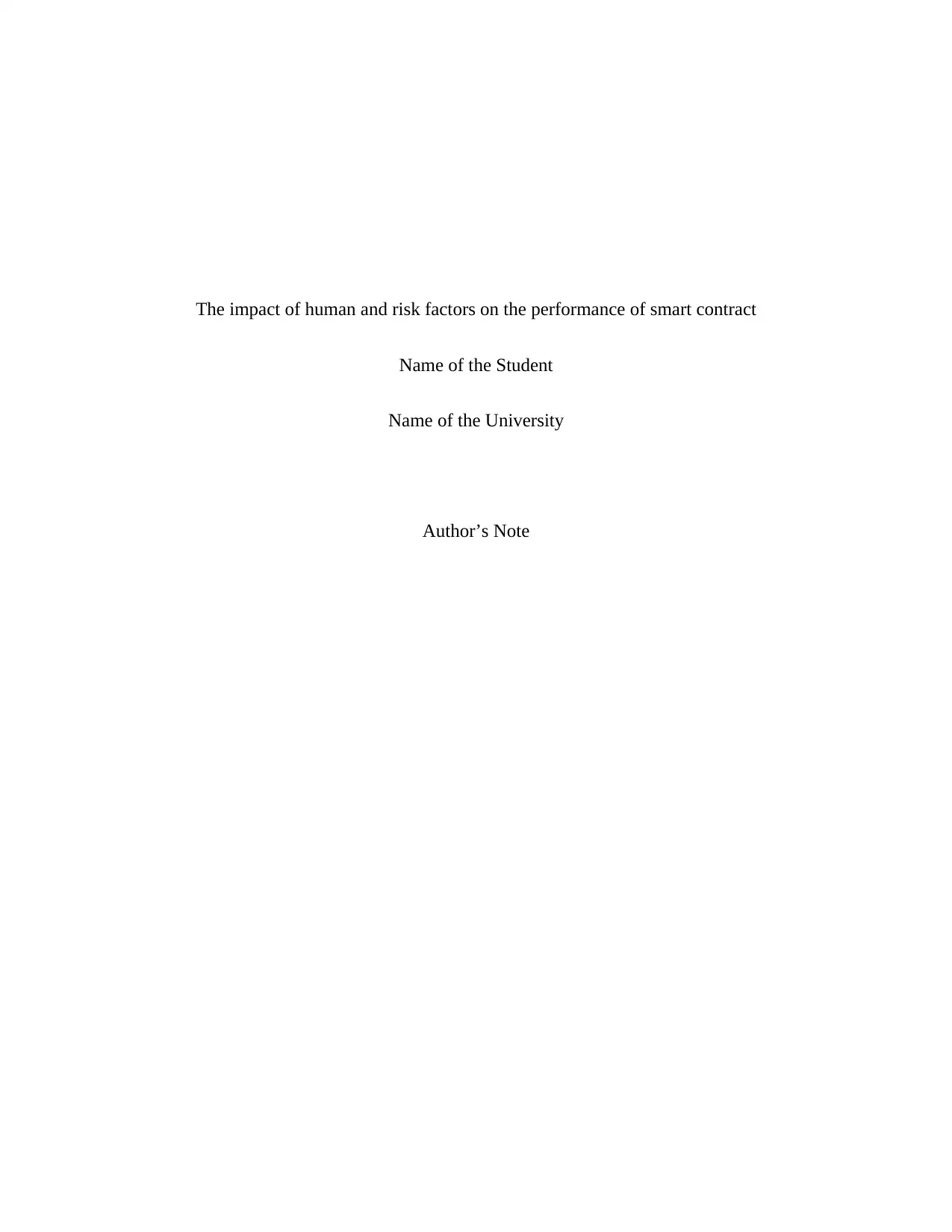
The impact of human and risk factors on the performance of smart contract
Name of the Student
Name of the University
Author’s Note
Name of the Student
Name of the University
Author’s Note
Paraphrase This Document
Need a fresh take? Get an instant paraphrase of this document with our AI Paraphraser
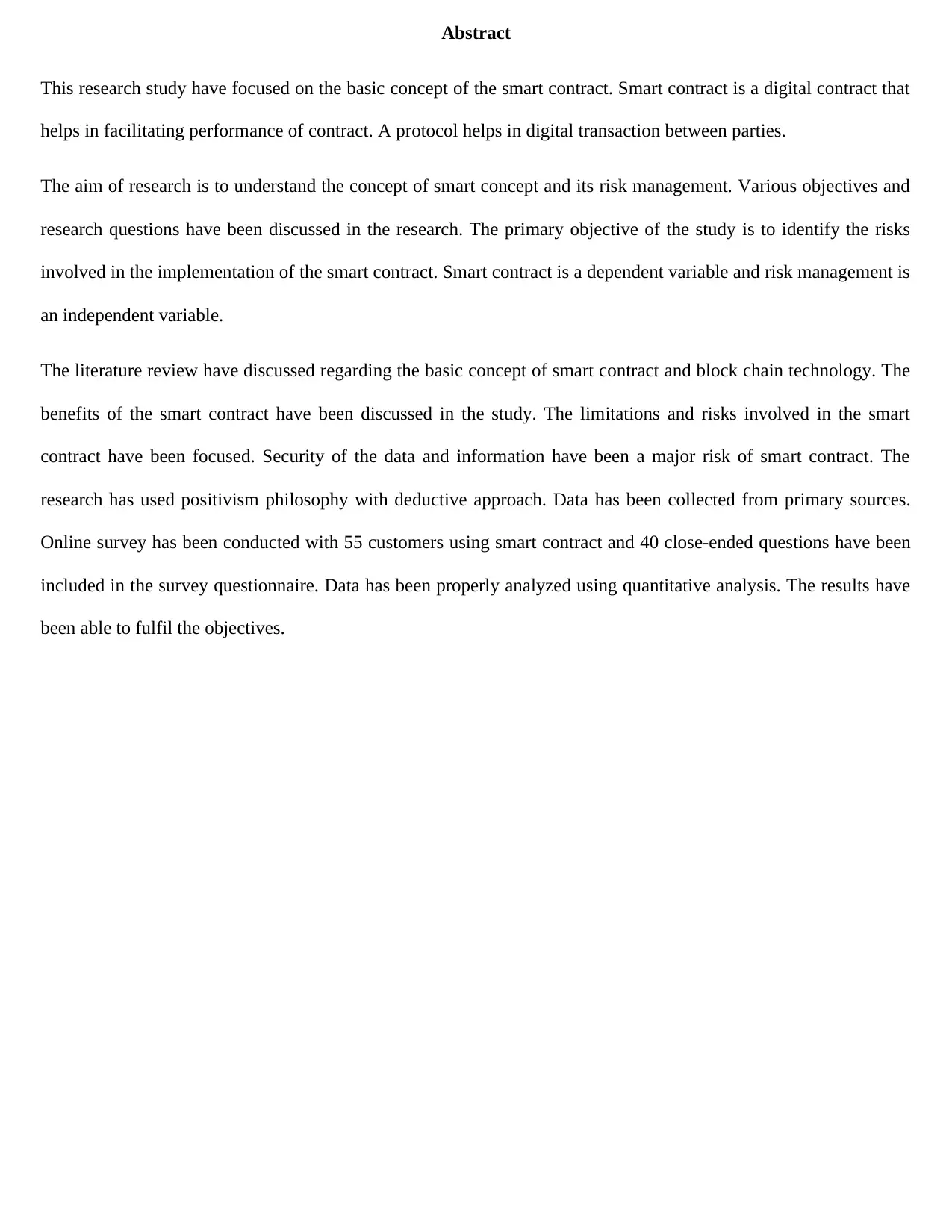
Abstract
This research study have focused on the basic concept of the smart contract. Smart contract is a digital contract that
helps in facilitating performance of contract. A protocol helps in digital transaction between parties.
The aim of research is to understand the concept of smart concept and its risk management. Various objectives and
research questions have been discussed in the research. The primary objective of the study is to identify the risks
involved in the implementation of the smart contract. Smart contract is a dependent variable and risk management is
an independent variable.
The literature review have discussed regarding the basic concept of smart contract and block chain technology. The
benefits of the smart contract have been discussed in the study. The limitations and risks involved in the smart
contract have been focused. Security of the data and information have been a major risk of smart contract. The
research has used positivism philosophy with deductive approach. Data has been collected from primary sources.
Online survey has been conducted with 55 customers using smart contract and 40 close-ended questions have been
included in the survey questionnaire. Data has been properly analyzed using quantitative analysis. The results have
been able to fulfil the objectives.
This research study have focused on the basic concept of the smart contract. Smart contract is a digital contract that
helps in facilitating performance of contract. A protocol helps in digital transaction between parties.
The aim of research is to understand the concept of smart concept and its risk management. Various objectives and
research questions have been discussed in the research. The primary objective of the study is to identify the risks
involved in the implementation of the smart contract. Smart contract is a dependent variable and risk management is
an independent variable.
The literature review have discussed regarding the basic concept of smart contract and block chain technology. The
benefits of the smart contract have been discussed in the study. The limitations and risks involved in the smart
contract have been focused. Security of the data and information have been a major risk of smart contract. The
research has used positivism philosophy with deductive approach. Data has been collected from primary sources.
Online survey has been conducted with 55 customers using smart contract and 40 close-ended questions have been
included in the survey questionnaire. Data has been properly analyzed using quantitative analysis. The results have
been able to fulfil the objectives.
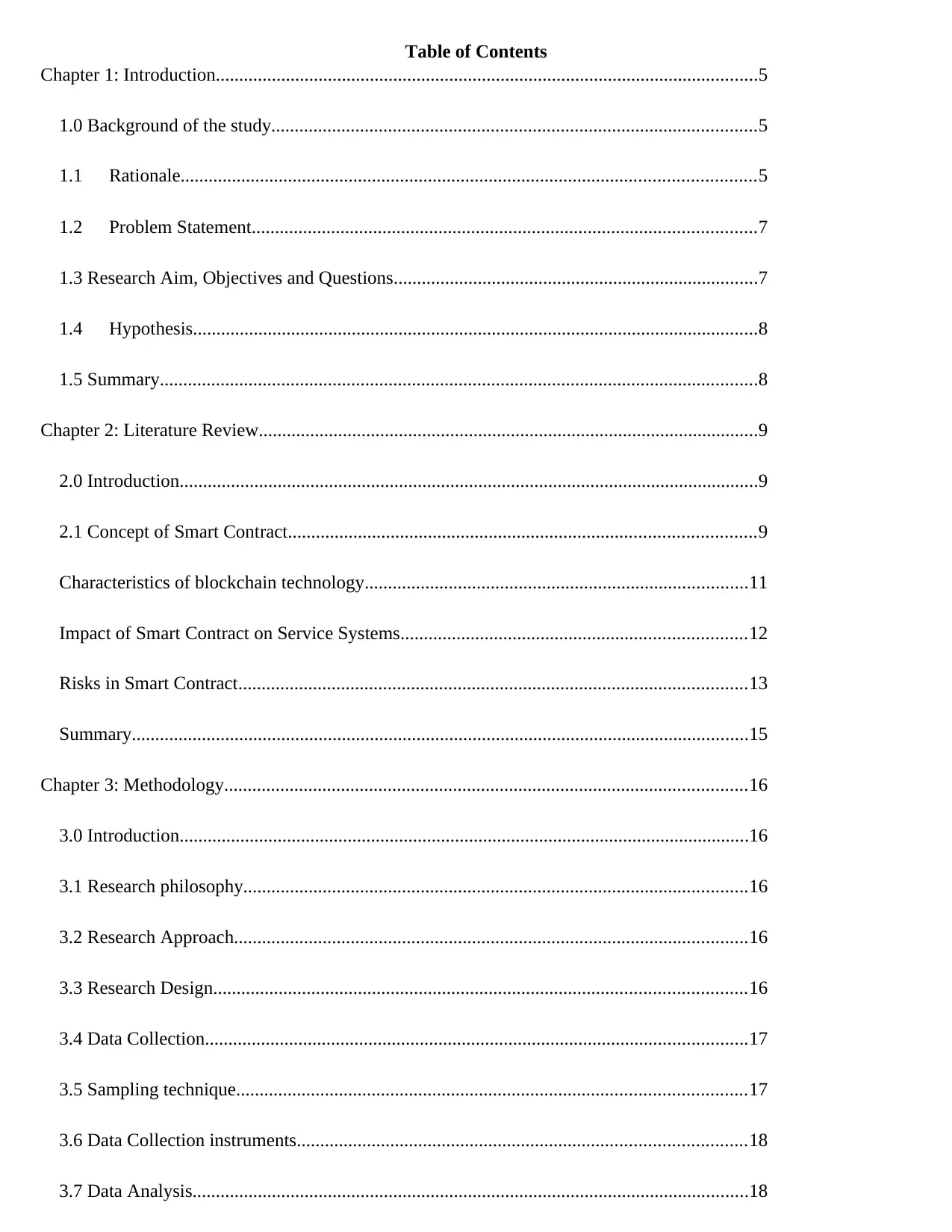
Table of Contents
Chapter 1: Introduction....................................................................................................................5
1.0 Background of the study........................................................................................................5
1.1 Rationale...........................................................................................................................5
1.2 Problem Statement............................................................................................................7
1.3 Research Aim, Objectives and Questions..............................................................................7
1.4 Hypothesis.........................................................................................................................8
1.5 Summary................................................................................................................................8
Chapter 2: Literature Review...........................................................................................................9
2.0 Introduction............................................................................................................................9
2.1 Concept of Smart Contract....................................................................................................9
Characteristics of blockchain technology..................................................................................11
Impact of Smart Contract on Service Systems..........................................................................12
Risks in Smart Contract.............................................................................................................13
Summary....................................................................................................................................15
Chapter 3: Methodology................................................................................................................16
3.0 Introduction..........................................................................................................................16
3.1 Research philosophy............................................................................................................16
3.2 Research Approach..............................................................................................................16
3.3 Research Design..................................................................................................................16
3.4 Data Collection....................................................................................................................17
3.5 Sampling technique.............................................................................................................17
3.6 Data Collection instruments................................................................................................18
3.7 Data Analysis.......................................................................................................................18
Chapter 1: Introduction....................................................................................................................5
1.0 Background of the study........................................................................................................5
1.1 Rationale...........................................................................................................................5
1.2 Problem Statement............................................................................................................7
1.3 Research Aim, Objectives and Questions..............................................................................7
1.4 Hypothesis.........................................................................................................................8
1.5 Summary................................................................................................................................8
Chapter 2: Literature Review...........................................................................................................9
2.0 Introduction............................................................................................................................9
2.1 Concept of Smart Contract....................................................................................................9
Characteristics of blockchain technology..................................................................................11
Impact of Smart Contract on Service Systems..........................................................................12
Risks in Smart Contract.............................................................................................................13
Summary....................................................................................................................................15
Chapter 3: Methodology................................................................................................................16
3.0 Introduction..........................................................................................................................16
3.1 Research philosophy............................................................................................................16
3.2 Research Approach..............................................................................................................16
3.3 Research Design..................................................................................................................16
3.4 Data Collection....................................................................................................................17
3.5 Sampling technique.............................................................................................................17
3.6 Data Collection instruments................................................................................................18
3.7 Data Analysis.......................................................................................................................18
⊘ This is a preview!⊘
Do you want full access?
Subscribe today to unlock all pages.

Trusted by 1+ million students worldwide
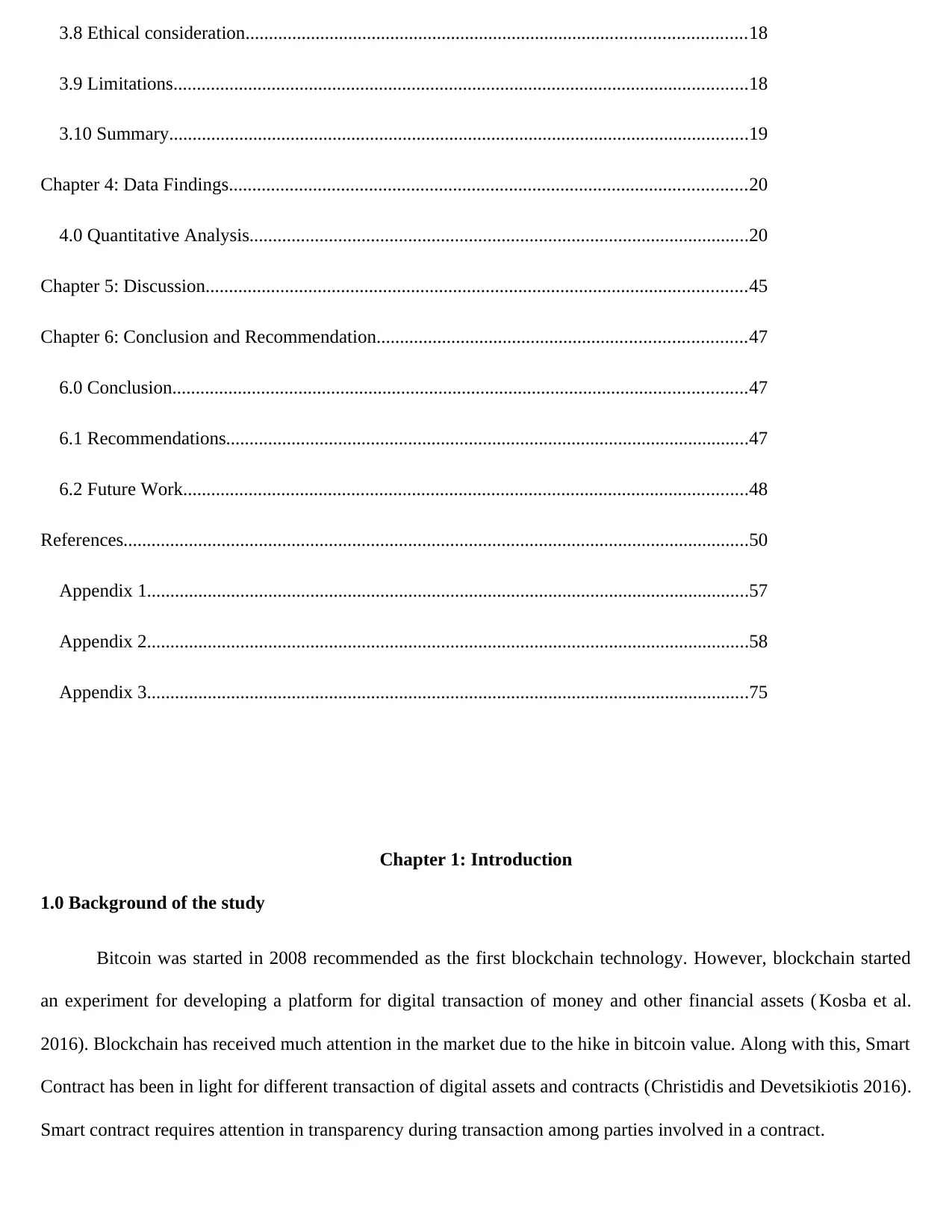
3.8 Ethical consideration...........................................................................................................18
3.9 Limitations...........................................................................................................................18
3.10 Summary............................................................................................................................19
Chapter 4: Data Findings...............................................................................................................20
4.0 Quantitative Analysis...........................................................................................................20
Chapter 5: Discussion....................................................................................................................45
Chapter 6: Conclusion and Recommendation...............................................................................47
6.0 Conclusion...........................................................................................................................47
6.1 Recommendations................................................................................................................47
6.2 Future Work.........................................................................................................................48
References......................................................................................................................................50
Appendix 1.................................................................................................................................57
Appendix 2.................................................................................................................................58
Appendix 3.................................................................................................................................75
Chapter 1: Introduction
1.0 Background of the study
Bitcoin was started in 2008 recommended as the first blockchain technology. However, blockchain started
an experiment for developing a platform for digital transaction of money and other financial assets ( Kosba et al.
2016). Blockchain has received much attention in the market due to the hike in bitcoin value. Along with this, Smart
Contract has been in light for different transaction of digital assets and contracts (Christidis and Devetsikiotis 2016).
Smart contract requires attention in transparency during transaction among parties involved in a contract.
3.9 Limitations...........................................................................................................................18
3.10 Summary............................................................................................................................19
Chapter 4: Data Findings...............................................................................................................20
4.0 Quantitative Analysis...........................................................................................................20
Chapter 5: Discussion....................................................................................................................45
Chapter 6: Conclusion and Recommendation...............................................................................47
6.0 Conclusion...........................................................................................................................47
6.1 Recommendations................................................................................................................47
6.2 Future Work.........................................................................................................................48
References......................................................................................................................................50
Appendix 1.................................................................................................................................57
Appendix 2.................................................................................................................................58
Appendix 3.................................................................................................................................75
Chapter 1: Introduction
1.0 Background of the study
Bitcoin was started in 2008 recommended as the first blockchain technology. However, blockchain started
an experiment for developing a platform for digital transaction of money and other financial assets ( Kosba et al.
2016). Blockchain has received much attention in the market due to the hike in bitcoin value. Along with this, Smart
Contract has been in light for different transaction of digital assets and contracts (Christidis and Devetsikiotis 2016).
Smart contract requires attention in transparency during transaction among parties involved in a contract.
Paraphrase This Document
Need a fresh take? Get an instant paraphrase of this document with our AI Paraphraser
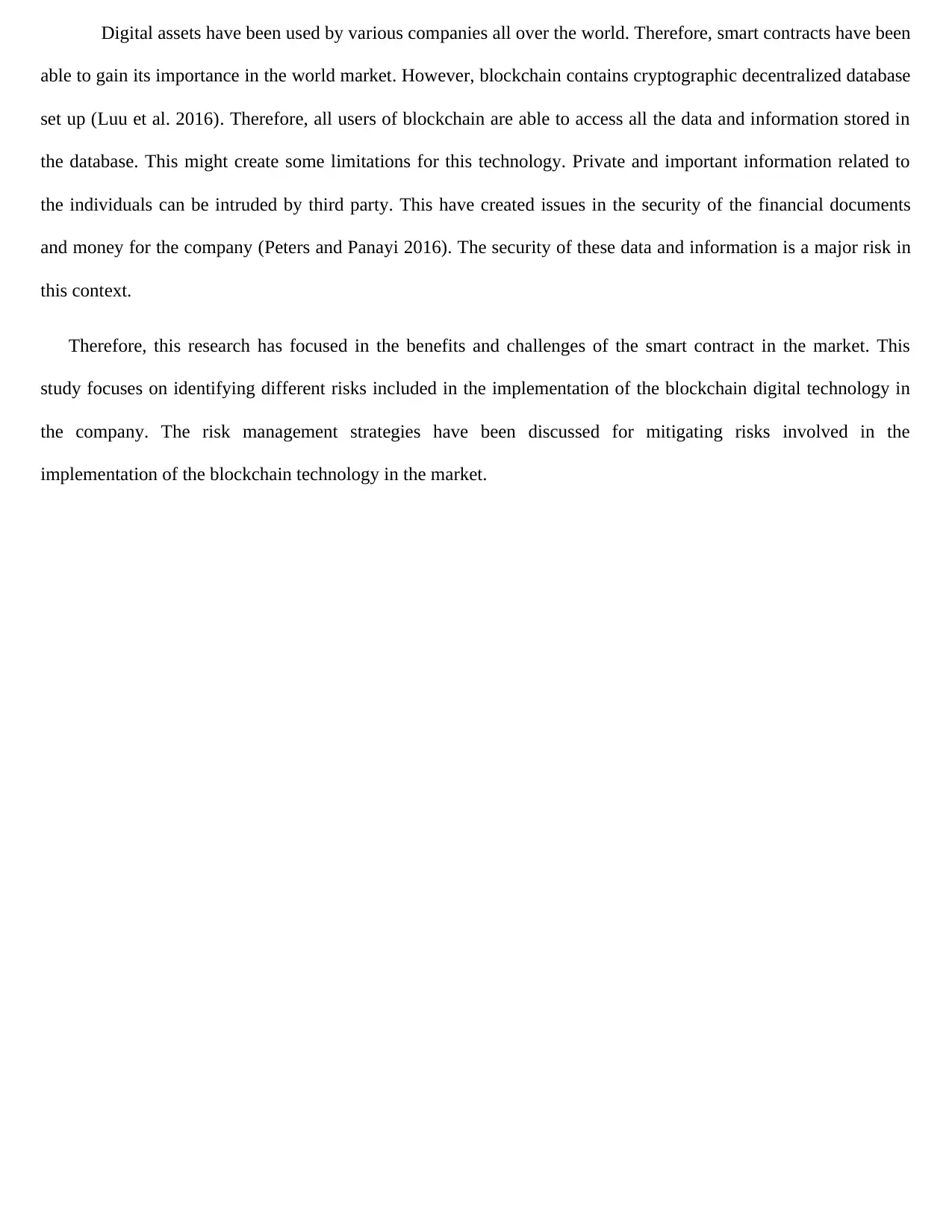
Digital assets have been used by various companies all over the world. Therefore, smart contracts have been
able to gain its importance in the world market. However, blockchain contains cryptographic decentralized database
set up (Luu et al. 2016). Therefore, all users of blockchain are able to access all the data and information stored in
the database. This might create some limitations for this technology. Private and important information related to
the individuals can be intruded by third party. This have created issues in the security of the financial documents
and money for the company (Peters and Panayi 2016). The security of these data and information is a major risk in
this context.
Therefore, this research has focused in the benefits and challenges of the smart contract in the market. This
study focuses on identifying different risks included in the implementation of the blockchain digital technology in
the company. The risk management strategies have been discussed for mitigating risks involved in the
implementation of the blockchain technology in the market.
able to gain its importance in the world market. However, blockchain contains cryptographic decentralized database
set up (Luu et al. 2016). Therefore, all users of blockchain are able to access all the data and information stored in
the database. This might create some limitations for this technology. Private and important information related to
the individuals can be intruded by third party. This have created issues in the security of the financial documents
and money for the company (Peters and Panayi 2016). The security of these data and information is a major risk in
this context.
Therefore, this research has focused in the benefits and challenges of the smart contract in the market. This
study focuses on identifying different risks included in the implementation of the blockchain digital technology in
the company. The risk management strategies have been discussed for mitigating risks involved in the
implementation of the blockchain technology in the market.
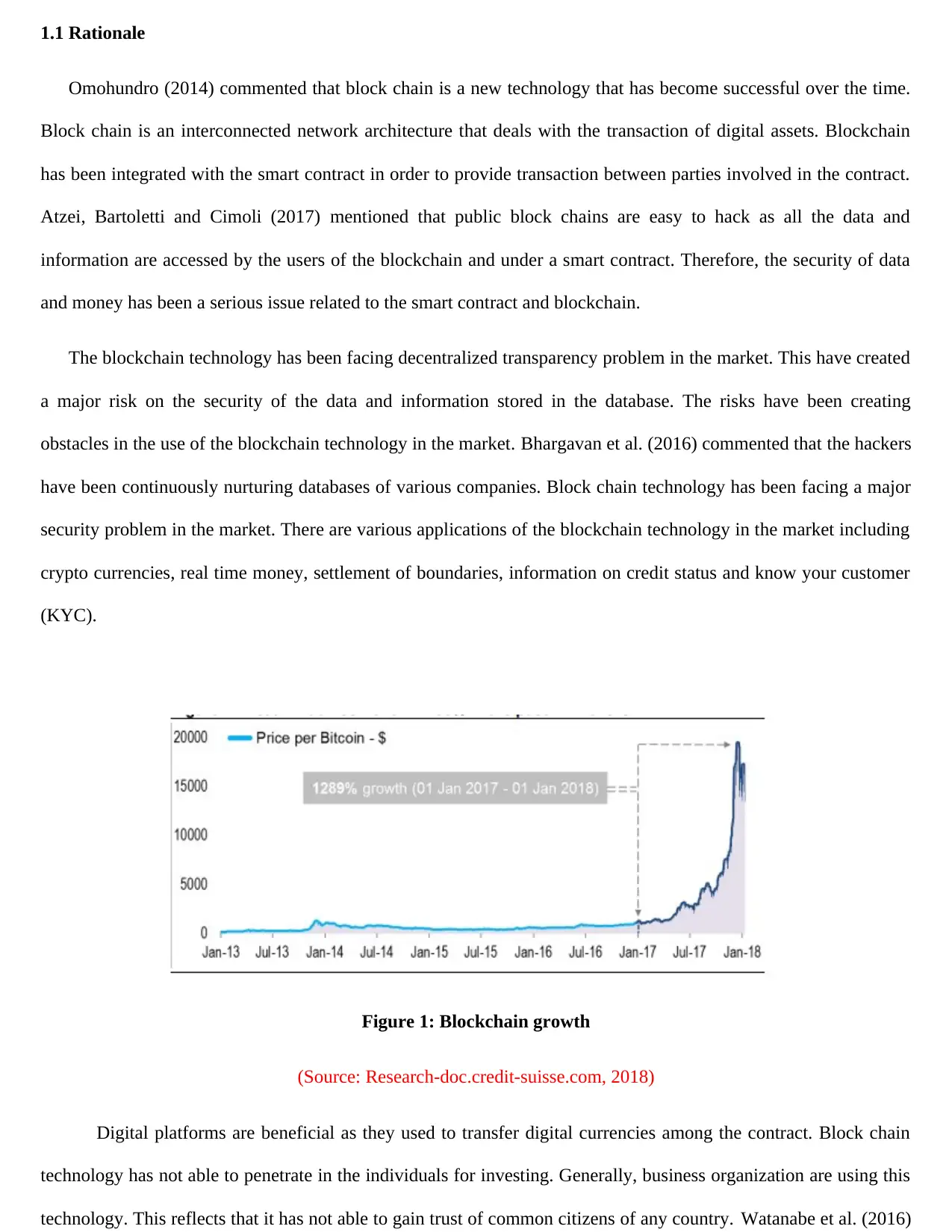
1.1 Rationale
Omohundro (2014) commented that block chain is a new technology that has become successful over the time.
Block chain is an interconnected network architecture that deals with the transaction of digital assets. Blockchain
has been integrated with the smart contract in order to provide transaction between parties involved in the contract.
Atzei, Bartoletti and Cimoli (2017) mentioned that public block chains are easy to hack as all the data and
information are accessed by the users of the blockchain and under a smart contract. Therefore, the security of data
and money has been a serious issue related to the smart contract and blockchain.
The blockchain technology has been facing decentralized transparency problem in the market. This have created
a major risk on the security of the data and information stored in the database. The risks have been creating
obstacles in the use of the blockchain technology in the market. Bhargavan et al. (2016) commented that the hackers
have been continuously nurturing databases of various companies. Block chain technology has been facing a major
security problem in the market. There are various applications of the blockchain technology in the market including
crypto currencies, real time money, settlement of boundaries, information on credit status and know your customer
(KYC).
Figure 1: Blockchain growth
(Source: Research-doc.credit-suisse.com, 2018)
Digital platforms are beneficial as they used to transfer digital currencies among the contract. Block chain
technology has not able to penetrate in the individuals for investing. Generally, business organization are using this
technology. This reflects that it has not able to gain trust of common citizens of any country. Watanabe et al. (2016)
Omohundro (2014) commented that block chain is a new technology that has become successful over the time.
Block chain is an interconnected network architecture that deals with the transaction of digital assets. Blockchain
has been integrated with the smart contract in order to provide transaction between parties involved in the contract.
Atzei, Bartoletti and Cimoli (2017) mentioned that public block chains are easy to hack as all the data and
information are accessed by the users of the blockchain and under a smart contract. Therefore, the security of data
and money has been a serious issue related to the smart contract and blockchain.
The blockchain technology has been facing decentralized transparency problem in the market. This have created
a major risk on the security of the data and information stored in the database. The risks have been creating
obstacles in the use of the blockchain technology in the market. Bhargavan et al. (2016) commented that the hackers
have been continuously nurturing databases of various companies. Block chain technology has been facing a major
security problem in the market. There are various applications of the blockchain technology in the market including
crypto currencies, real time money, settlement of boundaries, information on credit status and know your customer
(KYC).
Figure 1: Blockchain growth
(Source: Research-doc.credit-suisse.com, 2018)
Digital platforms are beneficial as they used to transfer digital currencies among the contract. Block chain
technology has not able to penetrate in the individuals for investing. Generally, business organization are using this
technology. This reflects that it has not able to gain trust of common citizens of any country. Watanabe et al. (2016)
⊘ This is a preview!⊘
Do you want full access?
Subscribe today to unlock all pages.

Trusted by 1+ million students worldwide
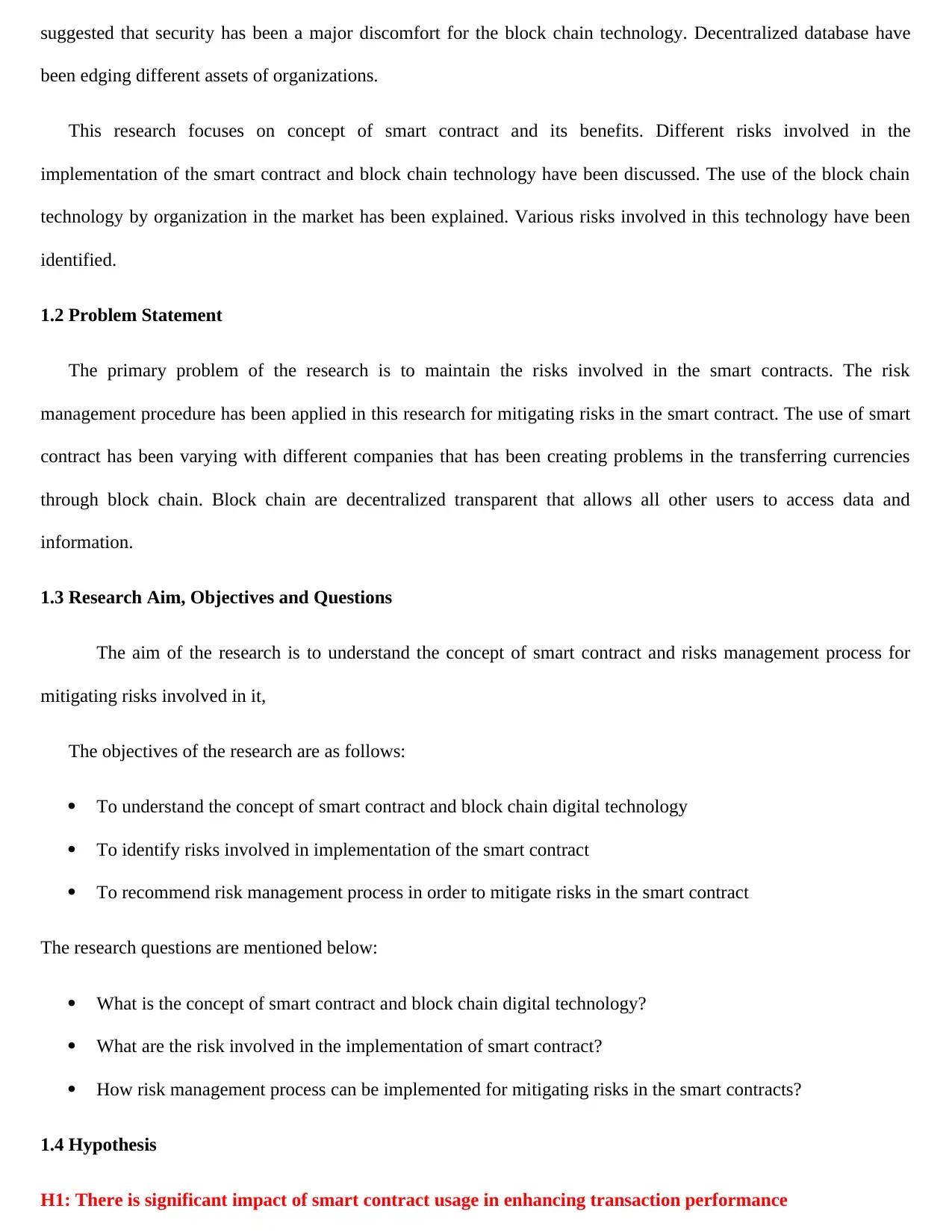
suggested that security has been a major discomfort for the block chain technology. Decentralized database have
been edging different assets of organizations.
This research focuses on concept of smart contract and its benefits. Different risks involved in the
implementation of the smart contract and block chain technology have been discussed. The use of the block chain
technology by organization in the market has been explained. Various risks involved in this technology have been
identified.
1.2 Problem Statement
The primary problem of the research is to maintain the risks involved in the smart contracts. The risk
management procedure has been applied in this research for mitigating risks in the smart contract. The use of smart
contract has been varying with different companies that has been creating problems in the transferring currencies
through block chain. Block chain are decentralized transparent that allows all other users to access data and
information.
1.3 Research Aim, Objectives and Questions
The aim of the research is to understand the concept of smart contract and risks management process for
mitigating risks involved in it,
The objectives of the research are as follows:
To understand the concept of smart contract and block chain digital technology
To identify risks involved in implementation of the smart contract
To recommend risk management process in order to mitigate risks in the smart contract
The research questions are mentioned below:
What is the concept of smart contract and block chain digital technology?
What are the risk involved in the implementation of smart contract?
How risk management process can be implemented for mitigating risks in the smart contracts?
1.4 Hypothesis
H1: There is significant impact of smart contract usage in enhancing transaction performance
been edging different assets of organizations.
This research focuses on concept of smart contract and its benefits. Different risks involved in the
implementation of the smart contract and block chain technology have been discussed. The use of the block chain
technology by organization in the market has been explained. Various risks involved in this technology have been
identified.
1.2 Problem Statement
The primary problem of the research is to maintain the risks involved in the smart contracts. The risk
management procedure has been applied in this research for mitigating risks in the smart contract. The use of smart
contract has been varying with different companies that has been creating problems in the transferring currencies
through block chain. Block chain are decentralized transparent that allows all other users to access data and
information.
1.3 Research Aim, Objectives and Questions
The aim of the research is to understand the concept of smart contract and risks management process for
mitigating risks involved in it,
The objectives of the research are as follows:
To understand the concept of smart contract and block chain digital technology
To identify risks involved in implementation of the smart contract
To recommend risk management process in order to mitigate risks in the smart contract
The research questions are mentioned below:
What is the concept of smart contract and block chain digital technology?
What are the risk involved in the implementation of smart contract?
How risk management process can be implemented for mitigating risks in the smart contracts?
1.4 Hypothesis
H1: There is significant impact of smart contract usage in enhancing transaction performance
Paraphrase This Document
Need a fresh take? Get an instant paraphrase of this document with our AI Paraphraser
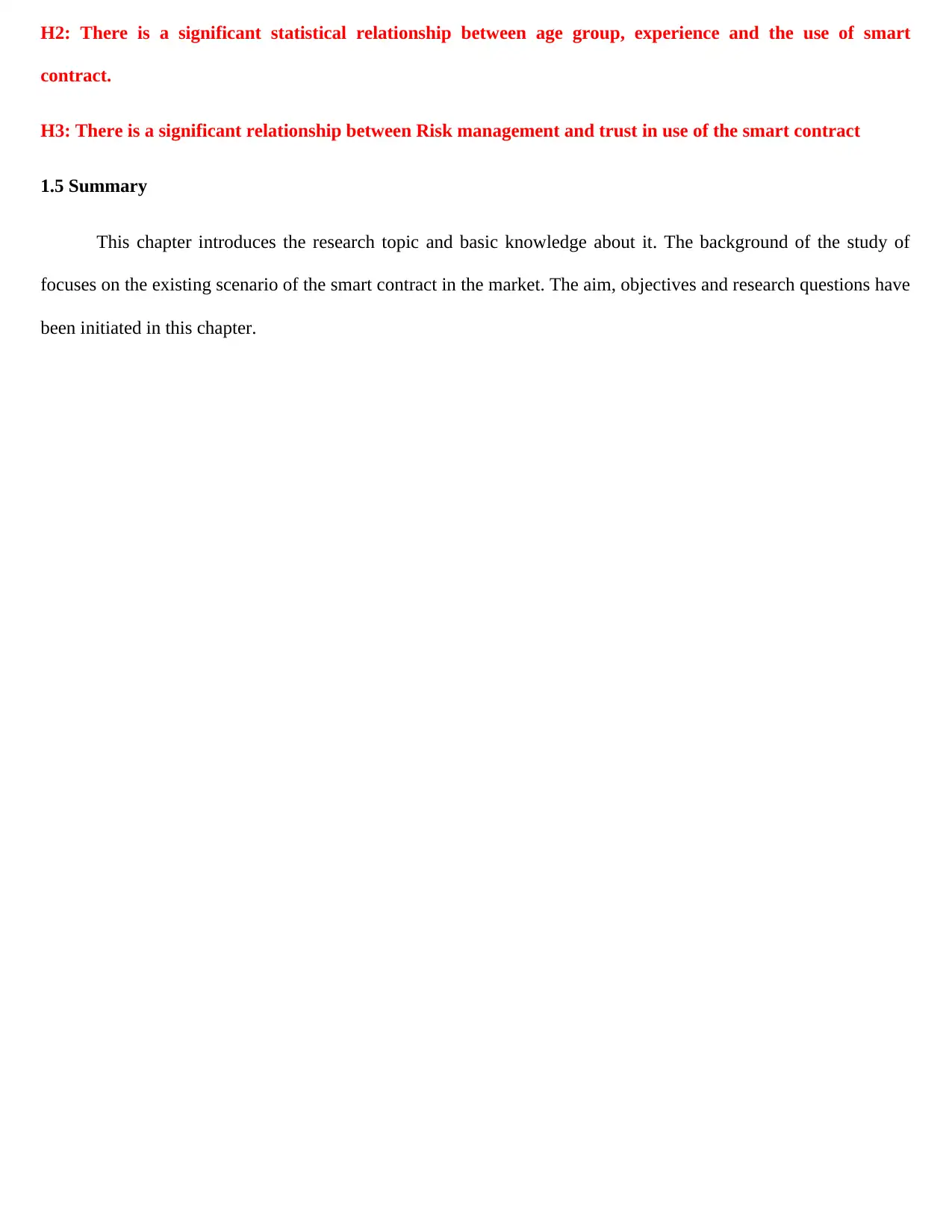
H2: There is a significant statistical relationship between age group, experience and the use of smart
contract.
H3: There is a significant relationship between Risk management and trust in use of the smart contract
1.5 Summary
This chapter introduces the research topic and basic knowledge about it. The background of the study of
focuses on the existing scenario of the smart contract in the market. The aim, objectives and research questions have
been initiated in this chapter.
contract.
H3: There is a significant relationship between Risk management and trust in use of the smart contract
1.5 Summary
This chapter introduces the research topic and basic knowledge about it. The background of the study of
focuses on the existing scenario of the smart contract in the market. The aim, objectives and research questions have
been initiated in this chapter.
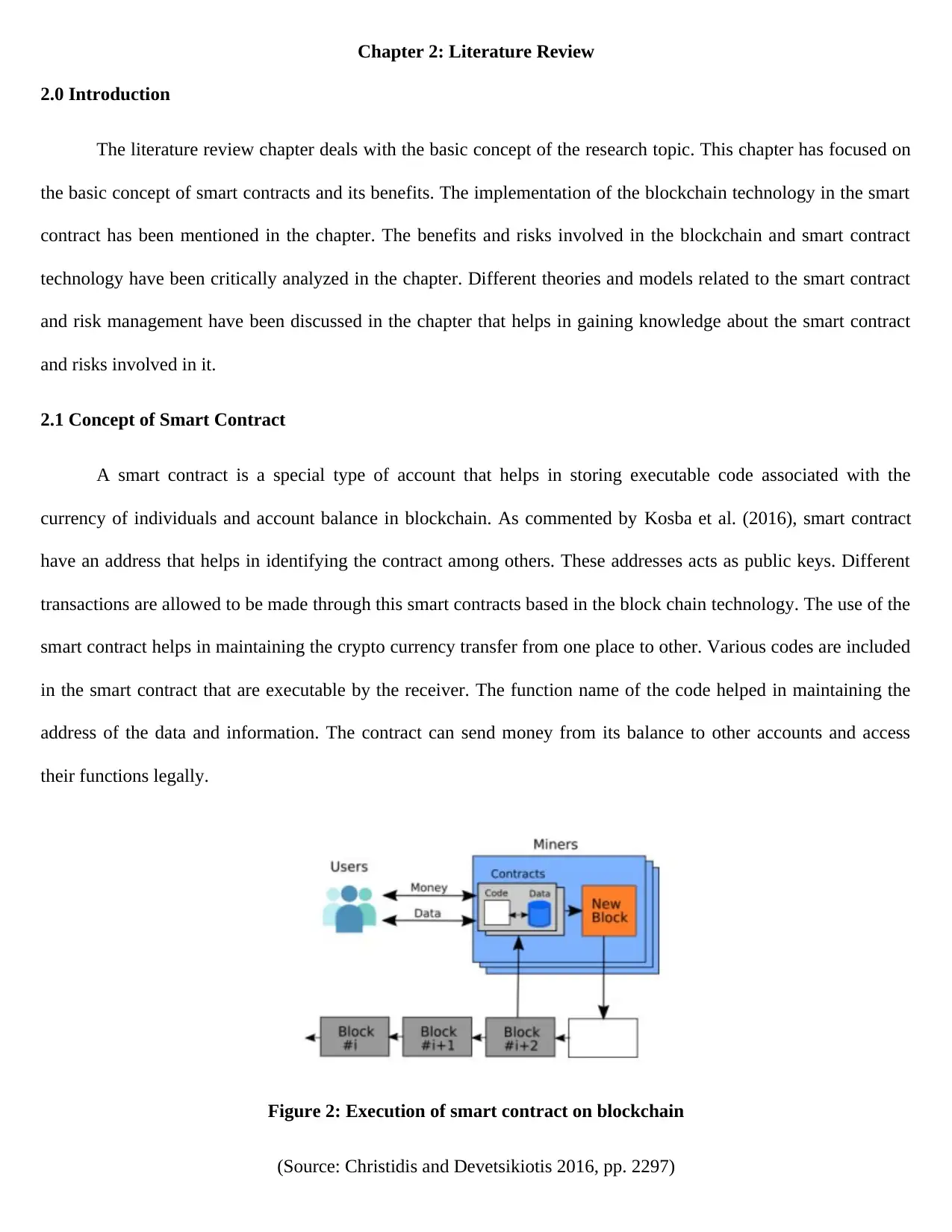
Chapter 2: Literature Review
2.0 Introduction
The literature review chapter deals with the basic concept of the research topic. This chapter has focused on
the basic concept of smart contracts and its benefits. The implementation of the blockchain technology in the smart
contract has been mentioned in the chapter. The benefits and risks involved in the blockchain and smart contract
technology have been critically analyzed in the chapter. Different theories and models related to the smart contract
and risk management have been discussed in the chapter that helps in gaining knowledge about the smart contract
and risks involved in it.
2.1 Concept of Smart Contract
A smart contract is a special type of account that helps in storing executable code associated with the
currency of individuals and account balance in blockchain. As commented by Kosba et al. (2016), smart contract
have an address that helps in identifying the contract among others. These addresses acts as public keys. Different
transactions are allowed to be made through this smart contracts based in the block chain technology. The use of the
smart contract helps in maintaining the crypto currency transfer from one place to other. Various codes are included
in the smart contract that are executable by the receiver. The function name of the code helped in maintaining the
address of the data and information. The contract can send money from its balance to other accounts and access
their functions legally.
Figure 2: Execution of smart contract on blockchain
(Source: Christidis and Devetsikiotis 2016, pp. 2297)
2.0 Introduction
The literature review chapter deals with the basic concept of the research topic. This chapter has focused on
the basic concept of smart contracts and its benefits. The implementation of the blockchain technology in the smart
contract has been mentioned in the chapter. The benefits and risks involved in the blockchain and smart contract
technology have been critically analyzed in the chapter. Different theories and models related to the smart contract
and risk management have been discussed in the chapter that helps in gaining knowledge about the smart contract
and risks involved in it.
2.1 Concept of Smart Contract
A smart contract is a special type of account that helps in storing executable code associated with the
currency of individuals and account balance in blockchain. As commented by Kosba et al. (2016), smart contract
have an address that helps in identifying the contract among others. These addresses acts as public keys. Different
transactions are allowed to be made through this smart contracts based in the block chain technology. The use of the
smart contract helps in maintaining the crypto currency transfer from one place to other. Various codes are included
in the smart contract that are executable by the receiver. The function name of the code helped in maintaining the
address of the data and information. The contract can send money from its balance to other accounts and access
their functions legally.
Figure 2: Execution of smart contract on blockchain
(Source: Christidis and Devetsikiotis 2016, pp. 2297)
⊘ This is a preview!⊘
Do you want full access?
Subscribe today to unlock all pages.

Trusted by 1+ million students worldwide
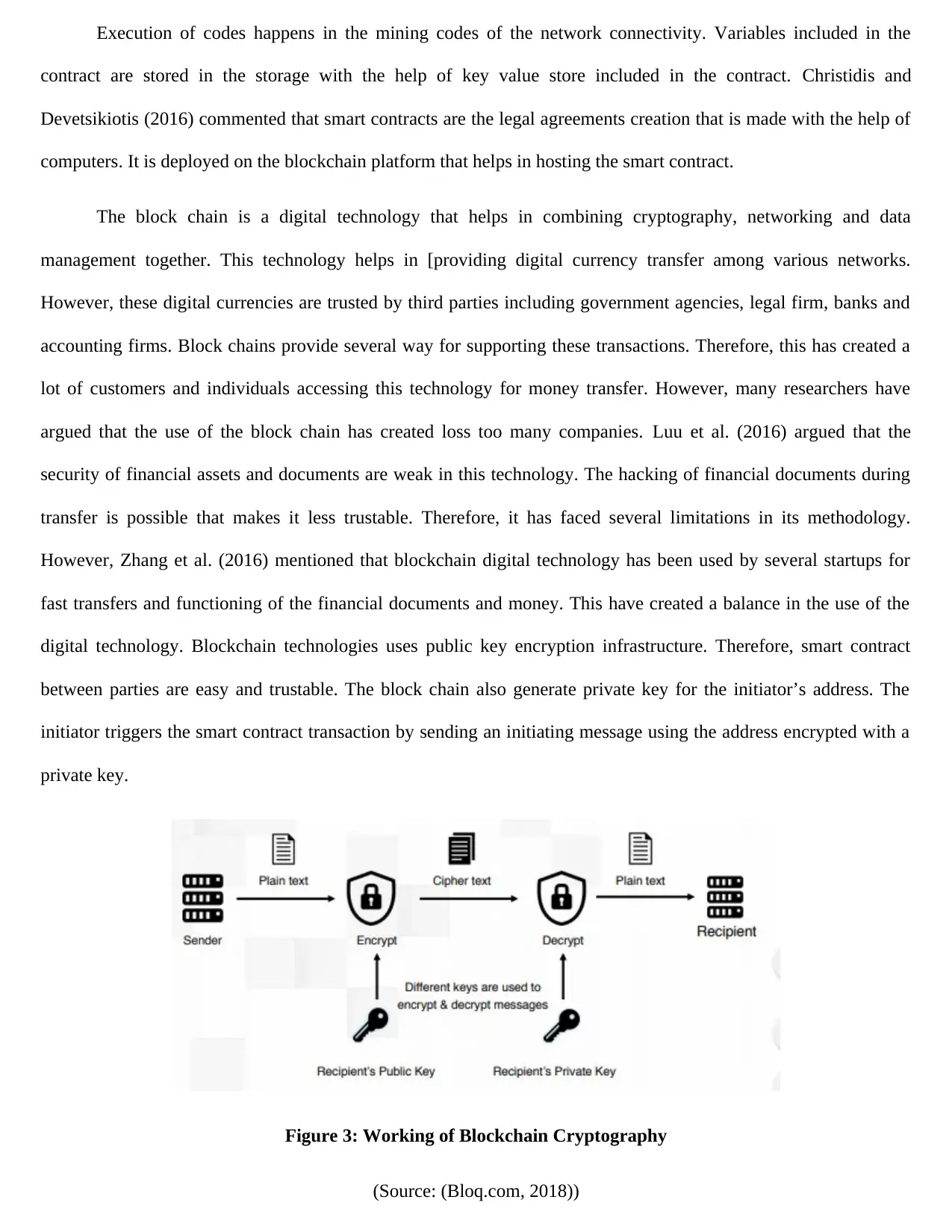
Execution of codes happens in the mining codes of the network connectivity. Variables included in the
contract are stored in the storage with the help of key value store included in the contract. Christidis and
Devetsikiotis (2016) commented that smart contracts are the legal agreements creation that is made with the help of
computers. It is deployed on the blockchain platform that helps in hosting the smart contract.
The block chain is a digital technology that helps in combining cryptography, networking and data
management together. This technology helps in [providing digital currency transfer among various networks.
However, these digital currencies are trusted by third parties including government agencies, legal firm, banks and
accounting firms. Block chains provide several way for supporting these transactions. Therefore, this has created a
lot of customers and individuals accessing this technology for money transfer. However, many researchers have
argued that the use of the block chain has created loss too many companies. Luu et al. (2016) argued that the
security of financial assets and documents are weak in this technology. The hacking of financial documents during
transfer is possible that makes it less trustable. Therefore, it has faced several limitations in its methodology.
However, Zhang et al. (2016) mentioned that blockchain digital technology has been used by several startups for
fast transfers and functioning of the financial documents and money. This have created a balance in the use of the
digital technology. Blockchain technologies uses public key encryption infrastructure. Therefore, smart contract
between parties are easy and trustable. The block chain also generate private key for the initiator’s address. The
initiator triggers the smart contract transaction by sending an initiating message using the address encrypted with a
private key.
Figure 3: Working of Blockchain Cryptography
(Source: (Bloq.com, 2018))
contract are stored in the storage with the help of key value store included in the contract. Christidis and
Devetsikiotis (2016) commented that smart contracts are the legal agreements creation that is made with the help of
computers. It is deployed on the blockchain platform that helps in hosting the smart contract.
The block chain is a digital technology that helps in combining cryptography, networking and data
management together. This technology helps in [providing digital currency transfer among various networks.
However, these digital currencies are trusted by third parties including government agencies, legal firm, banks and
accounting firms. Block chains provide several way for supporting these transactions. Therefore, this has created a
lot of customers and individuals accessing this technology for money transfer. However, many researchers have
argued that the use of the block chain has created loss too many companies. Luu et al. (2016) argued that the
security of financial assets and documents are weak in this technology. The hacking of financial documents during
transfer is possible that makes it less trustable. Therefore, it has faced several limitations in its methodology.
However, Zhang et al. (2016) mentioned that blockchain digital technology has been used by several startups for
fast transfers and functioning of the financial documents and money. This have created a balance in the use of the
digital technology. Blockchain technologies uses public key encryption infrastructure. Therefore, smart contract
between parties are easy and trustable. The block chain also generate private key for the initiator’s address. The
initiator triggers the smart contract transaction by sending an initiating message using the address encrypted with a
private key.
Figure 3: Working of Blockchain Cryptography
(Source: (Bloq.com, 2018))
Paraphrase This Document
Need a fresh take? Get an instant paraphrase of this document with our AI Paraphraser
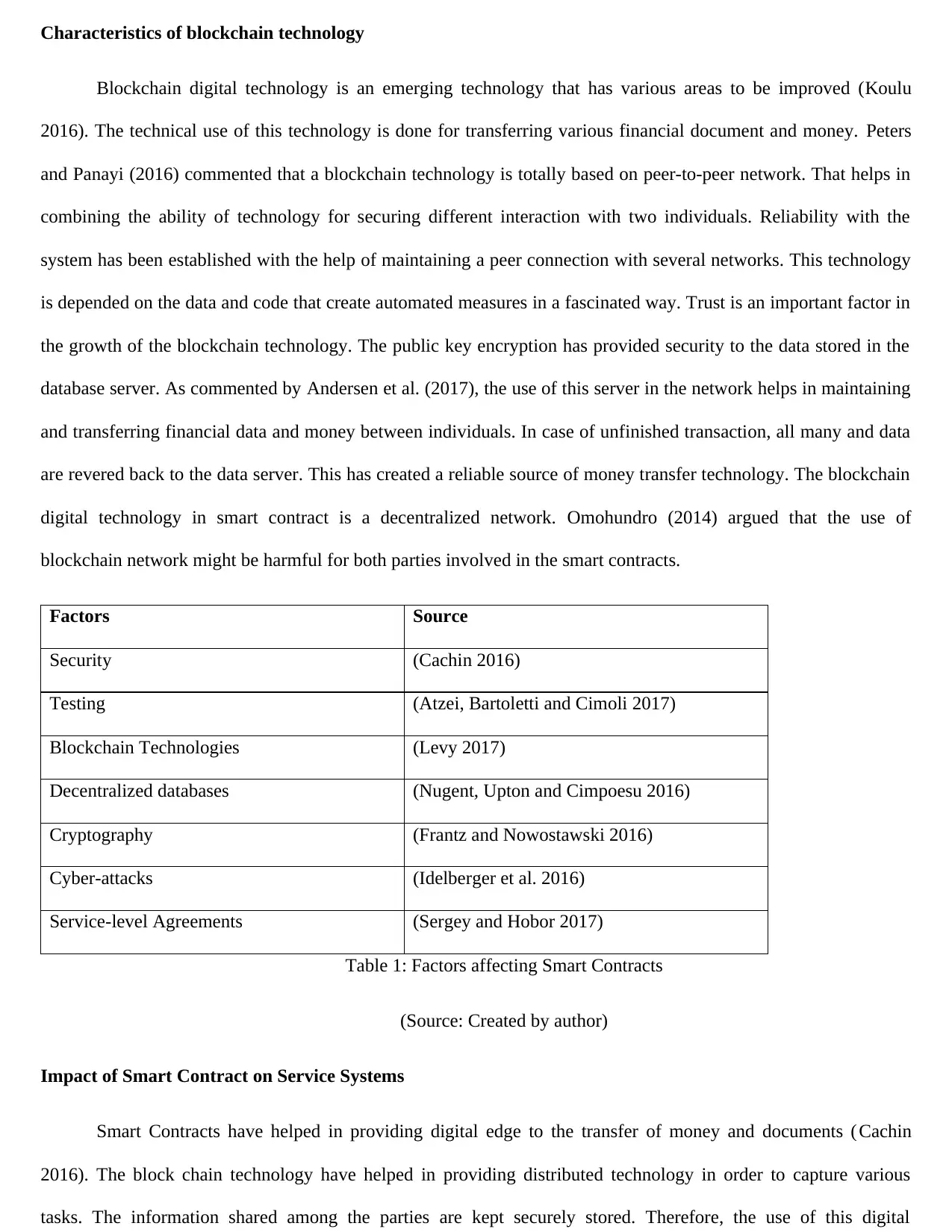
Characteristics of blockchain technology
Blockchain digital technology is an emerging technology that has various areas to be improved (Koulu
2016). The technical use of this technology is done for transferring various financial document and money. Peters
and Panayi (2016) commented that a blockchain technology is totally based on peer-to-peer network. That helps in
combining the ability of technology for securing different interaction with two individuals. Reliability with the
system has been established with the help of maintaining a peer connection with several networks. This technology
is depended on the data and code that create automated measures in a fascinated way. Trust is an important factor in
the growth of the blockchain technology. The public key encryption has provided security to the data stored in the
database server. As commented by Andersen et al. (2017), the use of this server in the network helps in maintaining
and transferring financial data and money between individuals. In case of unfinished transaction, all many and data
are revered back to the data server. This has created a reliable source of money transfer technology. The blockchain
digital technology in smart contract is a decentralized network. Omohundro (2014) argued that the use of
blockchain network might be harmful for both parties involved in the smart contracts.
Factors Source
Security (Cachin 2016)
Testing (Atzei, Bartoletti and Cimoli 2017)
Blockchain Technologies (Levy 2017)
Decentralized databases (Nugent, Upton and Cimpoesu 2016)
Cryptography (Frantz and Nowostawski 2016)
Cyber-attacks (Idelberger et al. 2016)
Service-level Agreements (Sergey and Hobor 2017)
Table 1: Factors affecting Smart Contracts
(Source: Created by author)
Impact of Smart Contract on Service Systems
Smart Contracts have helped in providing digital edge to the transfer of money and documents ( Cachin
2016). The block chain technology have helped in providing distributed technology in order to capture various
tasks. The information shared among the parties are kept securely stored. Therefore, the use of this digital
Blockchain digital technology is an emerging technology that has various areas to be improved (Koulu
2016). The technical use of this technology is done for transferring various financial document and money. Peters
and Panayi (2016) commented that a blockchain technology is totally based on peer-to-peer network. That helps in
combining the ability of technology for securing different interaction with two individuals. Reliability with the
system has been established with the help of maintaining a peer connection with several networks. This technology
is depended on the data and code that create automated measures in a fascinated way. Trust is an important factor in
the growth of the blockchain technology. The public key encryption has provided security to the data stored in the
database server. As commented by Andersen et al. (2017), the use of this server in the network helps in maintaining
and transferring financial data and money between individuals. In case of unfinished transaction, all many and data
are revered back to the data server. This has created a reliable source of money transfer technology. The blockchain
digital technology in smart contract is a decentralized network. Omohundro (2014) argued that the use of
blockchain network might be harmful for both parties involved in the smart contracts.
Factors Source
Security (Cachin 2016)
Testing (Atzei, Bartoletti and Cimoli 2017)
Blockchain Technologies (Levy 2017)
Decentralized databases (Nugent, Upton and Cimpoesu 2016)
Cryptography (Frantz and Nowostawski 2016)
Cyber-attacks (Idelberger et al. 2016)
Service-level Agreements (Sergey and Hobor 2017)
Table 1: Factors affecting Smart Contracts
(Source: Created by author)
Impact of Smart Contract on Service Systems
Smart Contracts have helped in providing digital edge to the transfer of money and documents ( Cachin
2016). The block chain technology have helped in providing distributed technology in order to capture various
tasks. The information shared among the parties are kept securely stored. Therefore, the use of this digital
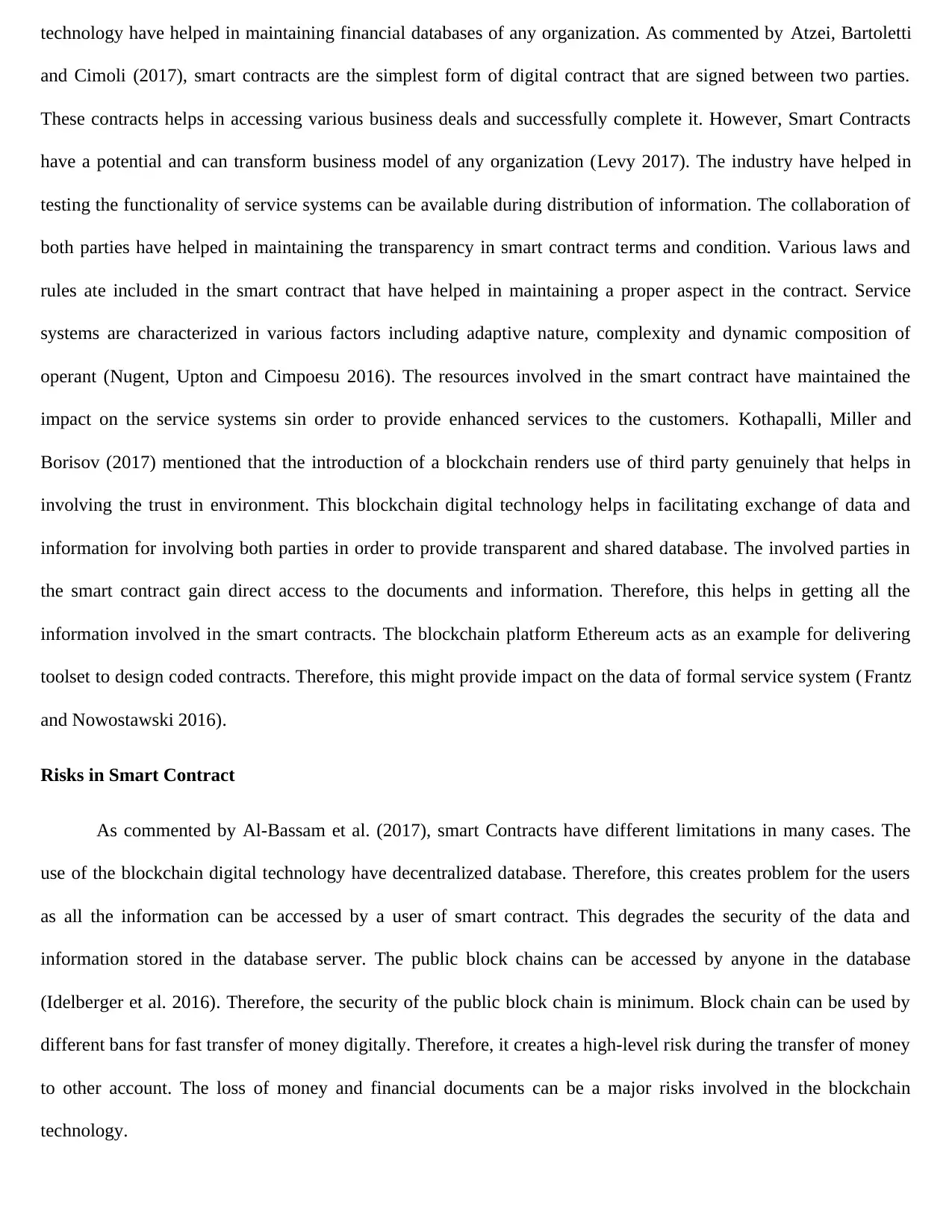
technology have helped in maintaining financial databases of any organization. As commented by Atzei, Bartoletti
and Cimoli (2017), smart contracts are the simplest form of digital contract that are signed between two parties.
These contracts helps in accessing various business deals and successfully complete it. However, Smart Contracts
have a potential and can transform business model of any organization (Levy 2017). The industry have helped in
testing the functionality of service systems can be available during distribution of information. The collaboration of
both parties have helped in maintaining the transparency in smart contract terms and condition. Various laws and
rules ate included in the smart contract that have helped in maintaining a proper aspect in the contract. Service
systems are characterized in various factors including adaptive nature, complexity and dynamic composition of
operant (Nugent, Upton and Cimpoesu 2016). The resources involved in the smart contract have maintained the
impact on the service systems sin order to provide enhanced services to the customers. Kothapalli, Miller and
Borisov (2017) mentioned that the introduction of a blockchain renders use of third party genuinely that helps in
involving the trust in environment. This blockchain digital technology helps in facilitating exchange of data and
information for involving both parties in order to provide transparent and shared database. The involved parties in
the smart contract gain direct access to the documents and information. Therefore, this helps in getting all the
information involved in the smart contracts. The blockchain platform Ethereum acts as an example for delivering
toolset to design coded contracts. Therefore, this might provide impact on the data of formal service system ( Frantz
and Nowostawski 2016).
Risks in Smart Contract
As commented by Al-Bassam et al. (2017), smart Contracts have different limitations in many cases. The
use of the blockchain digital technology have decentralized database. Therefore, this creates problem for the users
as all the information can be accessed by a user of smart contract. This degrades the security of the data and
information stored in the database server. The public block chains can be accessed by anyone in the database
(Idelberger et al. 2016). Therefore, the security of the public block chain is minimum. Block chain can be used by
different bans for fast transfer of money digitally. Therefore, it creates a high-level risk during the transfer of money
to other account. The loss of money and financial documents can be a major risks involved in the blockchain
technology.
and Cimoli (2017), smart contracts are the simplest form of digital contract that are signed between two parties.
These contracts helps in accessing various business deals and successfully complete it. However, Smart Contracts
have a potential and can transform business model of any organization (Levy 2017). The industry have helped in
testing the functionality of service systems can be available during distribution of information. The collaboration of
both parties have helped in maintaining the transparency in smart contract terms and condition. Various laws and
rules ate included in the smart contract that have helped in maintaining a proper aspect in the contract. Service
systems are characterized in various factors including adaptive nature, complexity and dynamic composition of
operant (Nugent, Upton and Cimpoesu 2016). The resources involved in the smart contract have maintained the
impact on the service systems sin order to provide enhanced services to the customers. Kothapalli, Miller and
Borisov (2017) mentioned that the introduction of a blockchain renders use of third party genuinely that helps in
involving the trust in environment. This blockchain digital technology helps in facilitating exchange of data and
information for involving both parties in order to provide transparent and shared database. The involved parties in
the smart contract gain direct access to the documents and information. Therefore, this helps in getting all the
information involved in the smart contracts. The blockchain platform Ethereum acts as an example for delivering
toolset to design coded contracts. Therefore, this might provide impact on the data of formal service system ( Frantz
and Nowostawski 2016).
Risks in Smart Contract
As commented by Al-Bassam et al. (2017), smart Contracts have different limitations in many cases. The
use of the blockchain digital technology have decentralized database. Therefore, this creates problem for the users
as all the information can be accessed by a user of smart contract. This degrades the security of the data and
information stored in the database server. The public block chains can be accessed by anyone in the database
(Idelberger et al. 2016). Therefore, the security of the public block chain is minimum. Block chain can be used by
different bans for fast transfer of money digitally. Therefore, it creates a high-level risk during the transfer of money
to other account. The loss of money and financial documents can be a major risks involved in the blockchain
technology.
⊘ This is a preview!⊘
Do you want full access?
Subscribe today to unlock all pages.

Trusted by 1+ million students worldwide
1 out of 89
Related Documents
Your All-in-One AI-Powered Toolkit for Academic Success.
+13062052269
info@desklib.com
Available 24*7 on WhatsApp / Email
![[object Object]](/_next/static/media/star-bottom.7253800d.svg)
Unlock your academic potential
Copyright © 2020–2025 A2Z Services. All Rights Reserved. Developed and managed by ZUCOL.




